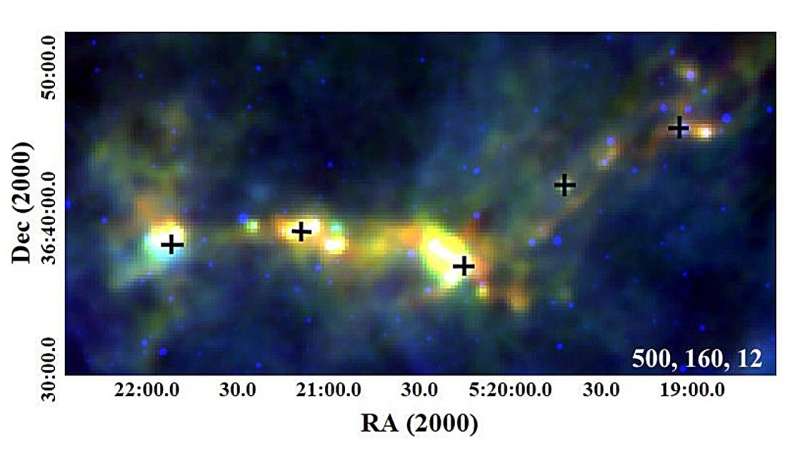April 18, 2024 report
This article has been reviewed according to Science X's editorial process and policies. Editors have highlighted the following attributes while ensuring the content's credibility:
fact-checked
peer-reviewed publication
trusted source
proofread
Researchers investigate three star-forming regions, identify hundreds young stellar objects

Using data from various space telescopes and astronomical surveys, Armenian researchers have investigated three star-forming regions. The study identified hundreds of young stellar objects and provided important information regarding the stellar content of these regions. The new findings were presented in a paper published April 5 in the Astrophysics and Space Science journal.
Star-forming regions are dense areas within molecular clouds in interstellar space where young stellar objects (YSOs) predominate and are likely being formed. Therefore, studying these regions is crucial for astronomers in order to better understand the formation and evolution of stars.
Recently, a team of astronomers led by Naira Azatyan of Byurakan Astrophysical Observatory in Armenia decided to explore three star-forming regions, namely IRAS 05137+3919, IRAS 05168+3634, and IRAS 19110+1045. They analyzed data covering a wide range of near- to far-infrared wavelengths.
"The selected regions (IRAS 05137+3919, 05168+3634, and 19110+1045), among other things, hold particular interest due to their considerable distances, providing an opportunity to evaluate the capabilities of the databases we have access to," the authors of the paper explained.
All the three investigated star-forming regions are located within 36,000 light years away from the Earth, have substantial sizes (with radii ranging from 5.5 to 6.2 light years) and showcase multi-component structures. The astronomers focused on the inspection of young stellar clusters and interstellar medium in these regions.
Azatyan's team managed to identify 33 YSOs in IRAS 05137+3919, 240 YSOs in IRAS 05168+3634 and 37 YSOs in IRAS 19110+1045. The researchers noted that in the IRAS 05137+3919 region the selected YSOs are not uniformly distributed and form two distinct subgroups.
The observations found five dense subgroups in the field of IRAS 05168+3634. It appears that the four of these subgroups and that star-forming region itself are embedded into a cloud complex about 85 light years long, located some 6,200 light years away.
According to the study, both IRAS 05137+3919 and IRAS 05168+3634 regions exhibit a wide age spread. This suggests that the stellar populations within these regions formed independently within the parent molecular clouds. In contrast, IRAS 19110+1045 harbors a pair of ultra-compact regions of ionized interstellar atomic hydrogen (HII regions), designated G45.12+0.13 and G45.07+0.13, with a notably smaller age spread.
The astronomers added that they detected massive stars only in IRAS 19110+1045, where star formation may have been triggered and the temperature and hydrogen column density of the interstellar medium are the highest among the three investigated regions.
More information: Naira Azatyan, Search and study of young infrared stellar clusters, Astrophysics and Space Science (2024). DOI: 10.1007/s10509-024-04298-3. On arXiv: DOI: 10.48550/arxiv.2404.05413
Journal information: Astrophysics and Space Science , arXiv
© 2024 Science X Network




















